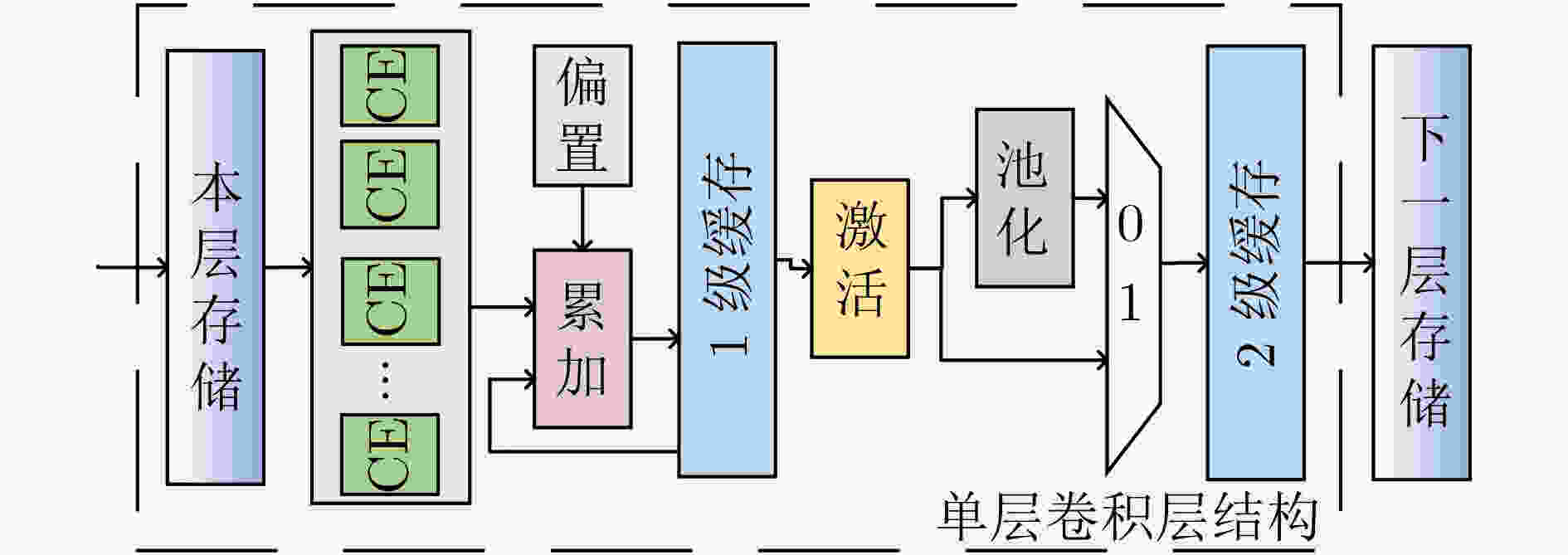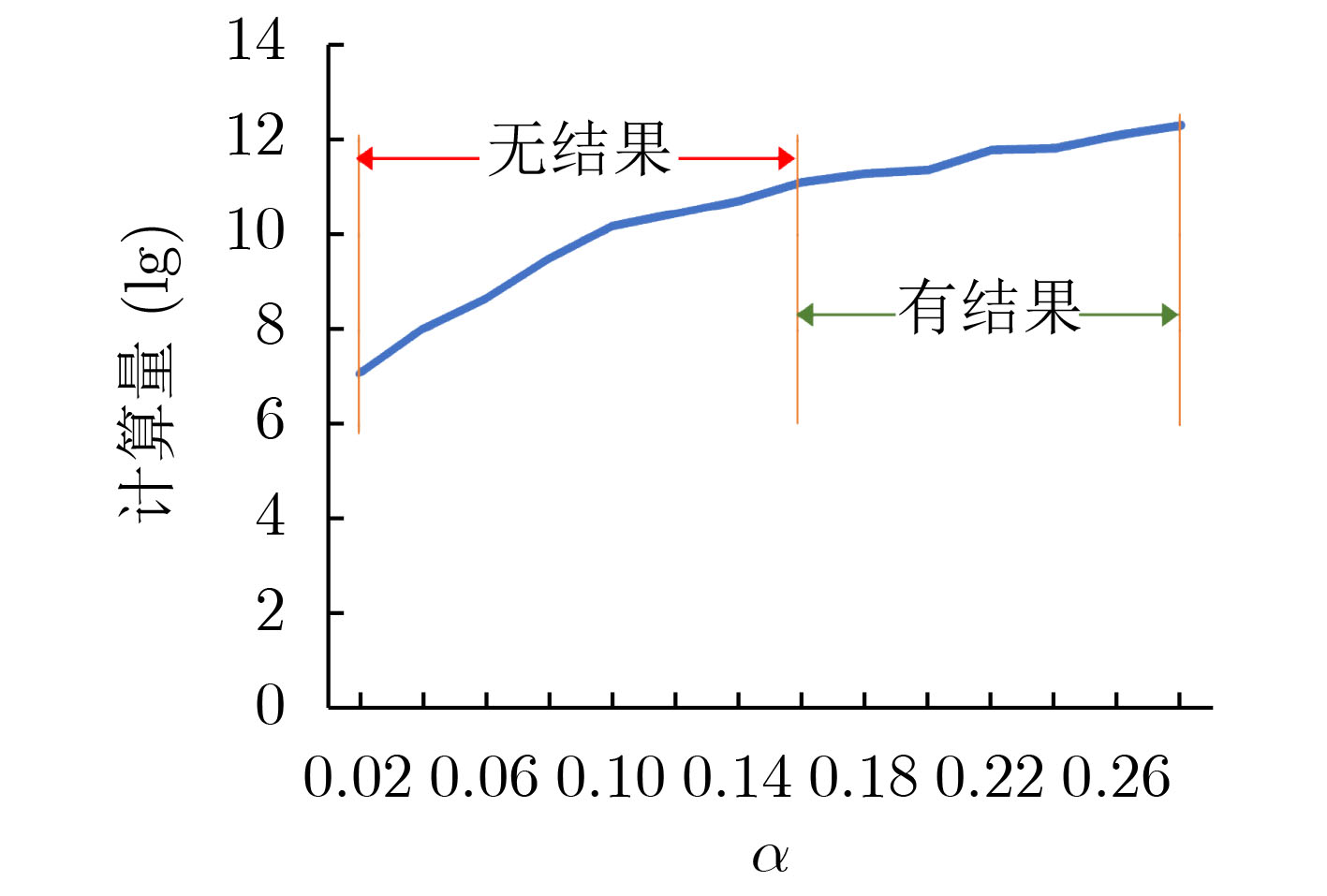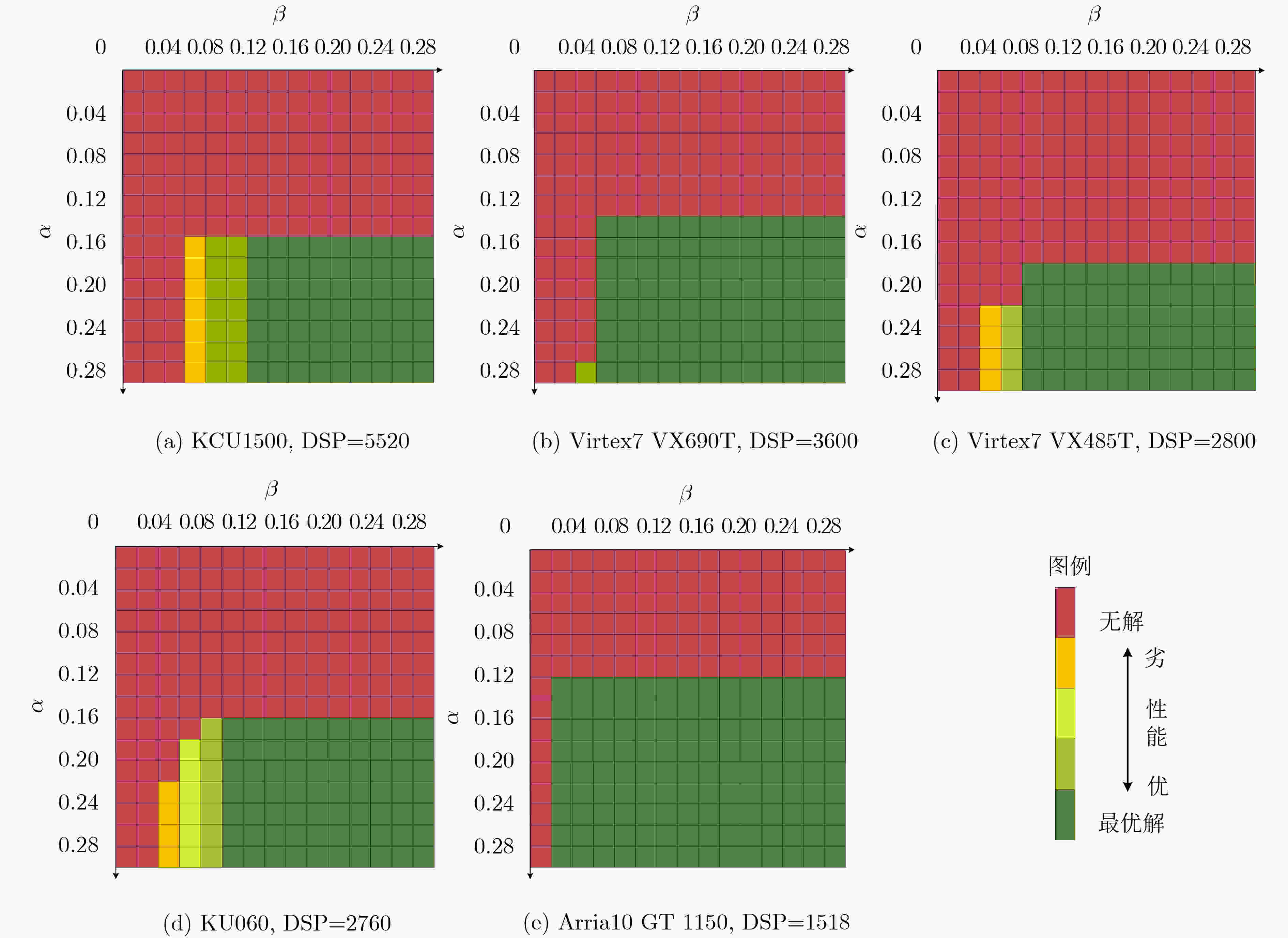A Parallelism Strategy Optimization Search Algorithm Based on Three-dimensional Deformable CNN Acceleration Architecture
-
摘要: 现场可编程门阵列(FPGA)被广泛应用于卷积神经网络(CNN)的硬件加速中。为优化加速器性能,Qu等人(2021)提出了一种3维可变换的CNN加速结构,但该结构使得并行度探索空间爆炸增长,搜索最优并行度的时间开销激增,严重降低了加速器实现的可行性。为此该文提出一种细粒度迭代优化的并行度搜索算法,该算法通过多轮迭代的数据筛选,高效地排除冗余的并行度方案,压缩了超过99%的搜索空间。同时算法采用剪枝操作删减无效的计算分支,成功地将计算所需时长从106 h量级减少到10 s内。该算法可适用于不同规格型号的FPGA芯片,其搜索得到的最优并行度方案性能突出,可在不同芯片上实现平均(R1, R2)达(0.957, 0.962)的卓越计算资源利用率。Abstract: Field Programmable Gate Array (FPGA) is widely used in Convolutional Neural Network (CNN) hardware acceleration. For better performance, a three-dimensional transformable CNN acceleration structure is proposed by Qu et al (2021). However, this structure brings an explosive growth of the parallelism strategy exploration space, thus the time cost to search the optimal parallelism has surged, which reduces severely the feasibility of accelerator implementation. To solve this issue, a fine-grained iterative optimization parallelism search algorithm is proposed in this paper. The algorithm uses multiple rounds of iterative data filtering to eliminate efficiently the redundant parallelism schemes, compressing more than 99% of the search space. At the same time, the algorithm uses pruning operation to delete invalid calculation branches, and reduces successfully the calculation time from 106 h to less than 10 s. The algorithm can achieve outstanding performance in different kinds of FPGAs, with an average computing resource utilization (R1, R2) up to (0.957, 0.962).
-
表 1 AlexNet网络结构参数
层 Nin Nout SIZEin SIZEout SIZEker Stride Npad CONV1 3 96 227 55 11 4 0 POOL1 96 96 55 27 3 2 0 CONV2 48 256 27 27 5 1 2 POOL2 256 256 27 13 3 2 0 CONV3 256 384 13 13 3 1 1 CONV4 192 384 13 13 3 1 1 CONV5 192 256 13 13 3 1 1 POOL5 256 256 13 6 3 2 0 FC1 9216 4096 1 1 – – – FC2 4096 4096 1 1 – – – FC3 4096 1000 1 1 – – – 表 2 不同FPGA CNN加速器的资源利用率
表 3 细粒度并行度迭代算法
输入:片上可用DSP数#DSPlimit、可用BRAM数量#BRAMlimit、CNN网络结构参数及α, β 输出:Parain,Paraout及Paraseg (1) 计算各层计算量#OPi与网络总计算量#OPtotal之比γi。 (2) 按照计算量分布比例将片上可用DSP分配给各层,各层分配到的DSP数#DSPialloc←γi·#DSPtotal (3)根据计算总量和计算资源总数,算出理论最小计算周期数#cyclebaseline。 (4) 第i层,遍历Parain,Paraout及ROWout的所有离散可行取值(即3者定义域形成的笛卡儿积),生成全组合情况下的并行度参数配置
集S0i,计算对应的#cyclei、#BRAMi与#DSPi。(5) 筛选满足α, β约束的数据集Si。 Si←select ele from S0i where (#cyclei/#cyclebaseline in [1–α,1+α] and #DSPi/#DSPialloc in [1–β,1+β]) (6)数据粗筛,集合S’i:任意相邻的两个元素不存在“KO”偏序关系。 for i in range(5): orders←[(cycle, dsp, bram), (dsp, cycle, bram), (bram, cycle, dsp)] for k in range(3): Si.sort_ascend_by(orders[k]) p←0 for j in range(1, size(Si)): if σj KO σp then Si.drop(σp), p←j else Si.drop(σj) S’i←Si (7)数据精筛,集合Ti:任意两个元素不存在“KO”偏序关系。 for i in range(5): S’i.sort_ascend_by((cycle,dsp,bram)) for j in range(1, size(S’i)): for k in range(j): if σk KO σj then S’i.drop(σj), break Ti←S’i (8)搜索剪枝。 maxCycle←INT_MAX, dspUsed←0, bramUsed←0 def calc(i): if i==5 then update(maxCycle) return for j in range(size(Ti)): tmpDsp←dspUsed+dspji, tmpBram←bramUsed+bramji if not(tmpDsp>dspTotal or tmpBram>bramTotal or cycleji≥maxCycle) then dspUsed←tmpDsp, bramUsed←tmpBram calc(i+1) dspUsed←tmpDsp-dspji, bramUsed←tmpBram-bramji else continue calc(0) (9)选出maxCycle(即min{max{#cyclei}})对应的并行度元素,输出约束条件下最优并行度的参数信息。 表 4 不同规格FPGA上AlexNet加速器资源利用率、计算量与计算时长
FPGA型号 DSP资源数 R1 R2 原始计算量 压缩比(%) 执行时间(s) Arria10 GT 1150 1518 0.987 0.989 5.683×107 99.892 1.544 KU060 2760 0.947 0.951 3.026×108 99.979 6.444 Virtex7 VX485T 2800 0.936 0.941 9.903×108 99.994 5.841 Virtex7 VX690T 3600 0.960 0.967 2.082×108 99.998 2.775 KCU1500 5520 0.955 0.962 5.772×109 99.999 8.115 表 5 AlexNet加速器性能对比
-
[1] LECUN Y, BOTTOU L, BENGIO Y, et al. Gradient-based learning applied to document recognition[J]. Proceedings of the IEEE, 1998, 86(11): 2278–2324. doi: 10.1109/5.726791 [2] QU Xinyuan, HUANG Zhihong, XU Yu, et al. Cheetah: An accurate assessment mechanism and a high-throughput acceleration architecture oriented toward resource efficiency[J]. IEEE Transactions on Computer-Aided Design of Integrated Circuits and Systems, 2021, 40(5): 878–891. doi: 10.1109/TCAD.2020.3011650 [3] REGGIANI E, RABOZZI M, NESTOROV A M, et al. Pareto optimal design space exploration for accelerated CNN on FPGA[C]. 2019 IEEE International Parallel and Distributed Processing Symposium Workshops (IPDPSW), Rio de Janeiro, Brazil, 2019: 107–114. doi: 10.1109/IPDPSW.2019.00028. [4] YU Xiaoyu, WANG Yuwei, MIAO Jie, et al. A data-center FPGA acceleration platform for convolutional neural networks[C]. 2019 29th International Conference on Field Programmable Logic and Applications (FPL), Barcelona, Spain, 2019: 151–158. doi: 10.1109/FPL.2019.00032. [5] LIU Zhiqiang, CHOW P, XU Jinwei, et al. A uniform architecture design for accelerating 2D and 3D CNNs on FPGAs[J]. Electronics, 2019, 8(1): 65. doi: 10.3390/electronics8010065 [6] LI Huimin, FAN Xitian, JIAO Li, et al. A high performance FPGA-based accelerator for large-scale convolutional neural networks[C]. 2016 26th International Conference on Field Programmable Logic and Applications (FPL), Lausanne, Swiss, 2016: 1–9. doi: 10.1109/FPL.2016.7577308. [7] QIU Jiantao, WANG Jie, YAO Song, et al. Going deeper with embedded FPGA platform for convolutional neural network[C]. The 2016 ACM/SIGDA International Symposium on Field-Programmable Gate Arrays, California, USA, 2016: 26–35. [8] ZHANG Xiaofan, WANG Junsong, ZHU Chao, et al. DNNBuilder: An automated tool for building high-performance DNN hardware accelerators for FPGAs[C]. 2018 IEEE/ACM International Conference on Computer-Aided Design (ICCAD), San Diego, USA, 2018: 1–8. doi: 10.1145/3240765.3240801. [9] LIU Zhiqiang, DOU Yong, JIANG Jingfei, et al. Automatic code generation of convolutional neural networks in FPGA implementation[C]. 2016 International Conference on Field-Programmable Technology (FPT), Xi’an, China, 2016: 61–68. doi: 10.1109/FPT.2016.7929190. [10] KRIZHEVSKY A, SUTSKEVER I, and HINTON G E. ImageNet classification with deep convolutional neural networks[J]. Communications of the ACM, 2017, 60(6): 84–90. doi: 10.1145/3065386 [11] MA Yufei, CAO Yu, VRUDHULA S, et al. Optimizing the convolution operation to accelerate deep neural networks on FPGA[J]. IEEE Transactions on Very Large Scale Integration (VLSI) Systems, 2018, 26(7): 1354–1367. doi: 10.1109/TVLSI.2018.2815603 [12] GUO Kaiyuan, SUI Lingzhi, QIU Jiantao, et al. Angel-Eye: A complete design flow for mapping CNN onto embedded FPGA[J]. IEEE Transactions on Computer-Aided Design of Integrated Circuits and Systems, 2018, 37(1): 35–47. doi: 10.1109/TCAD.2017.2705069 [13] ZHANG Chen, SUN Guangyu, FANG Zhenman, et al. Caffeine: Toward uniformed representation and acceleration for deep convolutional neural networks[J]. IEEE Transactions on Computer-Aided Design of Integrated Circuits and Systems, 2019, 38(11): 2072–2085. doi: 10.1109/TCAD.2017.2785257 [14] ZHANG Jialiang and LI Jing. Improving the performance of OpenCL-based FPGA accelerator for convolutional neural network[C]. The 2017 ACM/SIGDA International Symposium on Field-Programmable Gate Arrays, California, USA, 2017: 25–34. doi: 10.1145/3020078.3021698. [15] LIU Zhiqiang, DOU Yong, JIANG Jingfei, et al. Throughput-optimized FPGA accelerator for deep convolutional neural networks[J]. ACM Transactions on Reconfigurable Technology and Systems, 2017, 10(3): 17. doi: 10.1145/3079758 -






 下载:
下载:





 下载:
下载:
